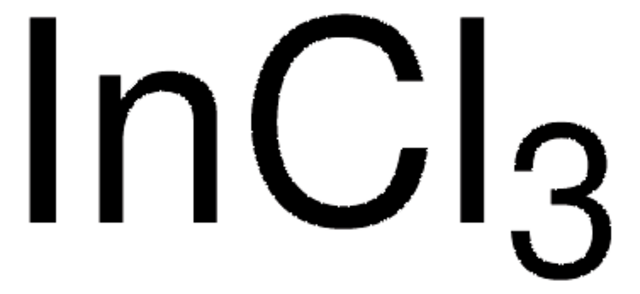651745
Copper(I) chloride
AnhydroBeads™, ≥99.99% trace metals basis
Synonym(s):
Copper monochloride, Cuprous chloride
About This Item
synthesis grade
Recommended Products
grade
for synthesis
synthesis grade
Quality Level
vapor pressure
1.3 mmHg ( 546 °C)
product line
AnhydroBeads™
Assay
≥99.99% trace metals basis
reaction suitability
reagent type: catalyst
core: copper
impurities
≤100.0 ppm Trace Metal Analysis
bp
1490 °C (lit.)
mp
430 °C (lit.)
solubility
slightly soluble 0.47 g/L at 20 °C
application(s)
battery manufacturing
SMILES string
Cl[Cu]
InChI
1S/ClH.Cu/h1H;/q;+1/p-1
InChI key
OXBLHERUFWYNTN-UHFFFAOYSA-M
Looking for similar products? Visit Product Comparison Guide
General description
Application
Legal Information
accessory
Signal Word
Danger
Hazard Statements
Precautionary Statements
Hazard Classifications
Acute Tox. 4 Dermal - Acute Tox. 4 Oral - Aquatic Acute 1 - Aquatic Chronic 1 - Eye Dam. 1 - Skin Irrit. 2
Storage Class Code
8A - Combustible corrosive hazardous materials
WGK
WGK 3
Flash Point(F)
Not applicable
Flash Point(C)
Not applicable
Personal Protective Equipment
Regulatory Listings
Regulatory Listings are mainly provided for chemical products. Only limited information can be provided here for non-chemical products. No entry means none of the components are listed. It is the user’s obligation to ensure the safe and legal use of the product.
PDSCL
Deleterious substance
ISHL Indicated Name
Substances Subject to be Indicated Names
ISHL Notified Names
Substances Subject to be Notified Names
JAN Code
651745-VAR:
651745-25G-PW:
651745-5G:4548173218144
651745-BULK:
651745-25G:4548173218137
651745-5G-PW:
Choose from one of the most recent versions:
Already Own This Product?
Find documentation for the products that you have recently purchased in the Document Library.
Customers Also Viewed
Articles
Nanostructured Materials Through Ultrasonic Spray Pyrolysis
Thermoelectric Performance of Perovskite-type Oxide Materials
Nanostructured Materials Through Ultrasonic Spray Pyrolysis
Spectral conversion for solar cells is an emerging concept in the field of photovoltaics, and it has the potential to increase significantly the efficiency of solar cells. Lanthanide ions are ideal candidates for spectral conversion, due to their high luminescence efficiencies and rich energy level structure that allows for great flexibility in the upconversion and downconversion of photons in a wide spectral region (NIR-VIS-UV).
Our team of scientists has experience in all areas of research including Life Science, Material Science, Chemical Synthesis, Chromatography, Analytical and many others.
Contact Technical Service










